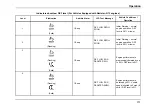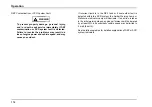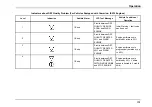
Operation
clutch pedal since the vehicle will experience erratic
engagement.
Erratic engagement can cause engine stalling and potential
serious damage to your vehicle’s drivetrain components (such
as clutch, transmission, driveshaft(s), and rear axle).
Hydraulic Clutch Actuation System
Clutch brake engagement occurs in the last 2 inches (50 mm)
of pedal travel after initial clutch setup adjustment. Clutch wear
will move the pedal position at clutch brake engagement toward
the physical limit of travel. The hydraulic clutch system must
have proper fluid bleeding before operating, usually performed
at the factory, or at field servicing. Hydraulic clutch fluid should
be drained and refilled every 2 years of service or after 200,000
miles (322,000 km) service interval.
CAUTION
To prevent vehicle and / or engine component
damage, clutch pedal must engage clutch brake
before the physical limit of pedal travel. When the
clutch pedal position at clutch brake engagement
is less than 0.5 inch (12.7 mm) from the physical
travel limit, manual clutch adjustment is required
for all Eaton
®
Easy Pedal
®
(EP) clutches.
If non-self adjusting clutches are used in this application, it is
important that clutch adjustments be maintained. Adjustment
intervals should be every 20,000 miles (32,000 km).
When
utilizing an Eaton
®
EP clutch with a hydraulic clutch actuator,
the cab clutch pedal cannot be used to indicate when clutch
adjustment is required. Drivers may not notice the need for
clutch adjustment and continue to drive in such condition. Lack
of adjustment will eventually lead to yoke interference with the
clutch cover causing extensive clutch and / or transmission
damage.
When using the clutch brake, fully depress the clutch pedal and
shift the transmission into either first or reverse gear. If the
transmission does not go into first gear or reverse, toothbutting
may be occurring. Slowly release the clutch pedal while applying
light pressure on the shift lever until the transmission goes into
gear. This will provide for a smooth shift into either a forward or
reverse gear.
NOTE: After engagement of first gear, DO NOT use the
clutch brake for upshifting and downshifting.
To do so
will shorten the service life of the clutch brake, and gear
selection shift efforts may be increased.
Clutch brake
application occurs in the last 2 inches (50 mm) of pedal
travel.
161
Summary of Contents for ProStar+
Page 4: ......
Page 24: ...Foreword 12...
Page 38: ...Model Description 26...
Page 74: ...Controls Features Declination Zone Map 62...
Page 98: ...Controls Features Center Dash Panel Wing Panel 86...
Page 118: ...Controls Features 106...
Page 243: ...Maintenance Instructions 231...
Page 286: ...Maintenance Intervals and Specifications 274...


































